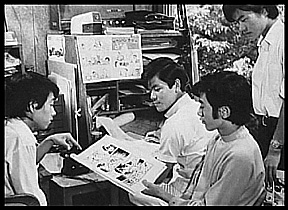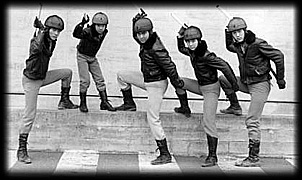|
Most of you reading
this probably got your first exposure to this team of five orphans
through Battle of the Planets in late 1978. But that show
was merely the final product of a skillful and delicate translation
of a previously-existing Japanese program called Science Ninja
Team Gatchaman. To better understand that program, one should
know about the people and the environment in which it was created.
Everything began
in 1932 when Tatsuo Yoshida was born in Kyoto, Japan. The eldest
of three brothers - the next being Kenji, and the youngest Toyoharu,
Tatsuo had a happy, though not rich childhood. Since their mother passed away shortly after Toyoharu was born, and their father was away in the Japanese army, their
extended family was close-knit and lived near one another
practically in the shadow of the city's famed Toji Temple.
The three youngsters were in frequent contact with
American soldiers during the American occupation of Japan. Most important to
their future careers was the influence of early American comic
books. The G.I.s would freely distribute these among the Japanese
children when they were finished reading them. The Yoshidas were
avid readers of Superman and other heroic tales. Even if
they couldn't understand the language, the pictures and art style
of the books captured their young attention and imaginations.
While looking through
these colorful books the children naturally began trying to draw pictures
of their new heroes. Those around Tatsuo and Toyoharu quickly realized the two had real talent for illustration. Tatsuo soon took advantage of his
newfound ability to illustrate pictures to help bring in extra
money for his family. It was reportedly a skill he truly enjoyed.
For many years he
kept going in Kyoto but it soon became obvious that he had reached
his limit in his hometown. Now married and just into his twenties,
Tatsuo decided that to proceed with his ambitions he would have
to move to the Japanese capital city of Tokyo. Mass-produced manga
(comic books patterned after the American models) were just beginning
to come into their own and Tokyo was the place to be for
their creation and production. So it was in May, 1954 that Tatsuo
and his wife packed their bags and said goodbye to Kyoto.
Soon after arriving
in Tokyo, Tatsuo landed a job at publishing house Akita Shoten
drawing for their Boys Girls Adventure King (Shonen Shojo
Boken O) monthly comic digest. He illustrated the wrestling
manga Iron Arm Rikiya (Tetsuwan Rikiya), for them
from March, 1955 through December, 1957. Work was steady and
demanding and near the end of his Iron Arm Rikiya run,
Tatsuo looked for help from his two brothers. At a mere seventeen
years old, youngest brother Toyoharu moved to Tokyo's outlying Shinkoiwa area with Tatsuo
to help work on art and other production tasks. Middle brother
Kenji also came on board but worked in more of a behind-the-scenes
capacity.
Toyoharu, who soon
worked exclusively under the pen-name Ippei Kuri (so he wouldn't
be confused with his brother), was not only able to help with
Tatsuo's tough schedule, but he was asked to begin illustrating
stories on his own. The manga business kept Tatsuo,
Kenji and Ippei very busy and they tackled over forty different
titles in the 1957 - 1962 period alone. Perhaps one of Tatsuo's
most satisfying projects was the chance to illustrate one of his
early heroes in its official Japanese version; Superman.
He worked on the Superman comic for publishing house Shonen
Gaho Sha from September 1959 through October, 1960.
 |
|
Kenji
Yoshida (holding art) |
By 1960 though, Tatsuo
was slowing down his illustration projects becoming increasingly
involved in the creation and coordination of getting comics made.
It must have suited him better than illustration jobs, as he had
a hand in helping to start a number of titles in the early sixties.
On October 1, 1962, Tatsuo officially named his illustration studio
Tatsunoko Productions and the company began the creation of its
own new works, while continuing to illustrate other monthly projects.
More and more illustration jobs were going to Ippei Kuri at this
point, who took them on happily. He had become an established
and much sought-after name in the industry.
Things were going
along splendidly when a monumental event took place in the beginning
of 1963. It effectively changed the direction Tatsuo saw for his
little company. It was called Iron-Arm Atom (Tetsuwan
Atomu, Astro Boy in America), and it was an animated
television program that had its origins at another famed manga
house, Tezuka Productions.
While Iron-Arm
Atom is widely cited as being the first Japanese animated
children's show, this is not true. A handful of other limited
animated programs beat it, but Iron-Arm Atom is unquestionably
the instigator for Japan's animation boom. The show was fast-paced,
adventurous and most importantly, fun. It caught Tatsuo's eye
and he knew he wanted to be involved in this medium above any other aspirations.
Tatsuo continued to lend his talents to comic adventures. One
of the most important of the late 1963 era would prove to be the
influential Boy Ninja Squad Moonlight (Shonen Ninja
Butai Gekko). It was created by Tatsunoko and Tatsuo and published
by Shonen Gaho Sha, where it ran from August 1, 1963 to February
10, 1965.
 |
|
Ninja
Squad Moonlight |
This Boy Ninja
Squad Moonlight comic was actually the springboard for the
first TV show that would include Tatsuo Yoshida's name. The series
was titled Ninja Squad Moonlight (Ninja Butai Gekko)
and ran from 1964 to 1966 for a total of 130 episodes. Many themes
that were present in Moonlight would turn up again in a
very familiar series, not the least of which was a multi-person
fighting team that sometimes included a female member and a child.
By 1964, Tatsunoko was still firmly in the business of comic creation, but the opportunity to change focus came quickly. Toei Animation studio called and asked if Tatsunoko would be able to produce an animated series like Ippei Kuri's popular Z-Boy comic. Quickly agreeing to the opportunity, Tatsuo sent his staff for animation training. It was during this training that they came up with the concept for Space Ace (Uchu E-su). The funding for the program fell through unfortunately, but since his staff had completed all their training, Tatsuo decided to move ahead with the series on his own. The animation bug had bitten and it became Tatsuo's consuming passion to see Space Ace completed.
He purchased a building for working space in Takanodai and soon after office spaces in what would be founded as Kokubunji, Japan (about 16 miles west of downtown Tokyo). It was a costly and expensive risk that was built on
nothing more than hope at that point, but Tatsuo must have had
the utmost belief in his staff and his project. His single-minded efforts to get Space Ace produced and on the air nearly broke the still-growing Tatsunoko Productions.
Finally, through
the help of sponsors like Kanebo (a
goods manufacturer) and publisher Shueisha (they printed Space
Ace comics in their Boys' Book periodical) plus the
faith of Fuji Television, Tatsuo's pet project Space Ace
made it to Japanese airwaves. The black and white production ran
for a full year from May 8, 1965 through April 28, 1966. Space
Ace was a certified hit and it cemented a relationship between
Tatsunoko and Fuji Television that led to many more
animated programs being developed.
As Space Ace
was running, Tatsuo and his staff, which now included friends
he had hired away from other animation studios and others with
whom he had worked in the manga trade, were hard at work developing
a host of new projects. Some came about and ended up on television, some didn't. But it was decided
that no matter what, their next production would be in full color.
Despite their newfound
excitement for animation, Tatsunoko Productions
continued to thrive at comic book production. Tatsuo was still
at the creative helm, but he was leaving more and more of the day-to-day
illustration and production of the titles up to his staff. His
most notable final comic project was the illustration of what
would soon become Tatsunoko's next animated program - Mach
GoGoGo (Mahha GoGoGo, or Speed Racer in America).
This comic was also published by Shueisha around the time of the
animated series' run.
Important differences
were to be found between Space Ace and Mach GoGoGo
however. The first series was more squarely aimed at young kids,
and it was a light hearted comedy. Mach GoGoGo was pure
adventure and excitement. Its very premise of a race car driver
squaring off against evil forces meant that the viewer was in
for a good dose of motor sports excitement each week.
The animation was
improved with Mach GoGoGo, new techniques were tried and
new dramatic storylines were put into play and the series was
also a success for Tatsunoko. Following it, a couple more comedic
series were produced, named I'm Guzura and Dokachin.
While not groundbreaking from any storytelling standpoints, they
did help to give Tatsunoko's animation staff more practice and
confidence. Both series included very limited experimentation
of blending live-action and animation.
When it came time
to tackle the studio's next drama, Kurenai Sanshiro in
1969, a very real attempt was made for the main characters to
look like real people. This was partially attempted with the lead
character Go Mifune in Mach GoGoGo, but his design still
had a somewhat wide-eyed cartoon look to it. The appearance
of the title character Sanshiro Kurenai was more serious, as was
the plot of the show - Sanshiro was traveling the lands on a quest to
find the villain who murdered his father.
Kurenai Sanshiro
was important for providing Tatsunoko with a field on which to
experiment. The opening credits featured a strobing/delayed effect
on the main character as he jumped his way onto the screen, plus
there were live-action shots inserted in the first episode that
featured a model of a ship being blown apart in a climactic scene.
The characters had to move and react more realistically given
their appearance and that was a major attraction that gave the
program a link to reality that few other animated series sought
to achieve.
From Kurenai Sanshiro's
short twenty-six episode run, through to the beginning of 1971,
very little serious experimentation was done. Tatsunoko produced
a series of comedic and light drama programs like Genie Hakushon
(Hakushon Dai Mao), Kabatotto and Honeybee
Hutch (Konshu Monogatari Minashigo Hatchi). But early
1971 saw the appearance of Decision (Ketsudan),
a serious and gritty look at World War II from the Japanese perspective.
This impressively animated program was able to depict the war
with hyper-realistic animation and an attention to detail that
had simply never been seen before on television.
Decision was
a true warm-up for their next drama - Production 21.

|

